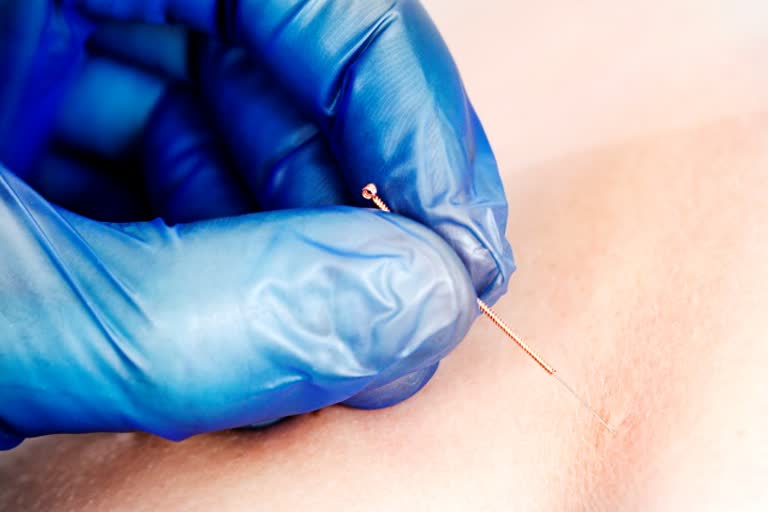Pain in muscles can be very distressful and the patient looks helter-skelter for any relieving measure insight. Dry needling has evolved from the observations that injection pricks helped in relieving pain and that the injection sites had something to do with it.
ETV Bharat Sukhibhava was in conversation with Dr. Janhvi Kathrani, Physiotherapist, Alternative Medicine Practitioner, and Yoga Teacher, to know more about this therapy.
Understanding DRY NEEDLING as they do it.
Dry Needling Therapy is mostly practiced by physiotherapists mainly to manage the pain as well as functional disabilities. Dry Needling as the name suggests is an invasive procedure in which Monofilament fine sterile disposable needle is inserted into the body through the skin to the depth needed as per requirement. Needles those being used in dry needling therapy are more than 10 times thinner than the injection needle [Injection needle is around 2.9mm while dry needling needles are around 0.16mm to 0.3mm]. Thus, it is less painful than clinical injections. All around the globe, Dry needling therapy is a highly recommended and widely accepted choice of treatment in trigger point management.
Two types of Dry Needling therapy is common:
1. Intramuscular Stimulation/intramuscular manual therapy (inserted into the particular muscle) commonly known as Deep Dry Needling and
2. Superficial Dry Needling (inserted, just above the muscle).
Also Read: 1 In 10 Mild COVID Survivors Face Loss Of Smell, Taste
Is Dry Needling the same as Acupuncture?
No. Dry Needling procedures are following the anatomy and physiology of the body while acupuncture mainly involves meridians (energy channels).
Why should I take Dry Needling Therapy?
- The fastest way to break the knots/taut bands/stiffness related to muscles.
- Multiple benefits.
- Accurate.
For what conditions should I take Dry Needling?
- If you are suffering from muscular pain or pain at any joints of the body.
- Tight muscles or stiffness in the muscles
- Neck pain or back pain
- Immovable scars or to enhance the scar healing
- Headaches (factors related to musculoskeletal system), migraine, tension headaches
- Trigger points or a taut band
- Radiating pain
- Chronic pain
- Musculoskeletal conditions like shoulder impingement, tennis/golfer’s elbow, frozen shoulder, plantar fasciitis (heel pain), tendinitis, calf pain or restlessness, etc.
- Post-operative orthopedic conditions.
- Nerve impingement. For example- sciatica.
- Functional impairments.
When should I avoid Dry Needling?
- Needle phobia
- Unwillingness due to certain cultural practices or beliefs)
- History of any reactions or complications with needling in the past.
- Medical emergency.
- Psychiatric patients (patients with mental health issues)
- Communication issues (age-related, language barrier, etc.)
- If no consent form is signed.
- Abnormal bleeding or patients on anticoagulation therapy, thrombocytopenia.
- Blood-borne disease, cancer, HIV
- Sepsis or even local infection at the site of pain.
- Dry Needling procedures are restricted in children below 5 due to the ongoing development of their musculoskeletal system. It is not preferred for geriatric patients too if they have severe weakness of musculature.
What all the Effects and benefits I can get after Dry Needling Therapy?
- Releases feel-good chemicals in the body (neurotransmitter).
- Promote healing by increasing local blood flow.
- Vitalize the site of dry needling by dealing with localized oxygen deficiency.
- Stimulate the natural analgesic (pain releasing) effects.
- Relaxation is achieved by reducing the tension/stress from the skin, fascia, and musculoskeletal structures.
- Enhances the local inflammation process, especially in chronic pain cases as the inflammatory changes result in healing the area.
For your queries, contact Dr. Janhvi Kathrani at jk.swasthya108@gmail.com



